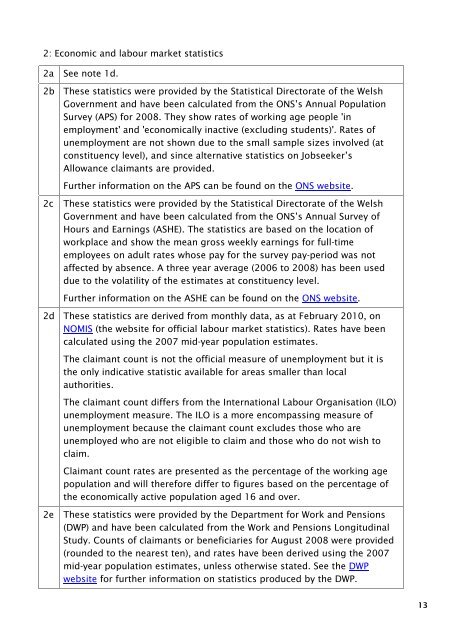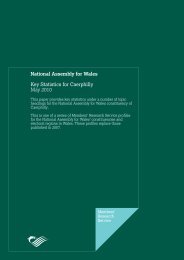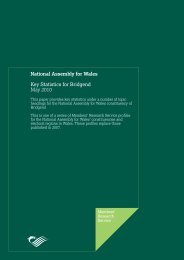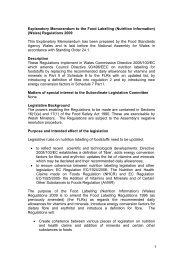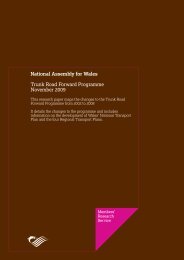Key Statistics for Newport West - National Assembly for Wales
Key Statistics for Newport West - National Assembly for Wales
Key Statistics for Newport West - National Assembly for Wales
Create successful ePaper yourself
Turn your PDF publications into a flip-book with our unique Google optimized e-Paper software.
2: Economic and labour market statistics<br />
2a See note 1d.<br />
2b These statistics were provided by the Statistical Directorate of the Welsh<br />
Government and have been calculated from the ONS’s Annual Population<br />
Survey (APS) <strong>for</strong> 2008. They show rates of working age people 'in<br />
employment' and 'economically inactive (excluding students)'. Rates of<br />
unemployment are not shown due to the small sample sizes involved (at<br />
constituency level), and since alternative statistics on Jobseeker’s<br />
Allowance claimants are provided.<br />
Further in<strong>for</strong>mation on the APS can be found on the ONS website.<br />
2c<br />
These statistics were provided by the Statistical Directorate of the Welsh<br />
Government and have been calculated from the ONS’s Annual Survey of<br />
Hours and Earnings (ASHE). The statistics are based on the location of<br />
workplace and show the mean gross weekly earnings <strong>for</strong> full-time<br />
employees on adult rates whose pay <strong>for</strong> the survey pay-period was not<br />
affected by absence. A three year average (2006 to 2008) has been used<br />
due to the volatility of the estimates at constituency level.<br />
Further in<strong>for</strong>mation on the ASHE can be found on the ONS website.<br />
2d These statistics are derived from monthly data, as at February 2010, on<br />
NOMIS (the website <strong>for</strong> official labour market statistics). Rates have been<br />
calculated using the 2007 mid-year population estimates.<br />
The claimant count is not the official measure of unemployment but it is<br />
the only indicative statistic available <strong>for</strong> areas smaller than local<br />
authorities.<br />
The claimant count differs from the International Labour Organisation (ILO)<br />
unemployment measure. The ILO is a more encompassing measure of<br />
unemployment because the claimant count excludes those who are<br />
unemployed who are not eligible to claim and those who do not wish to<br />
claim.<br />
Claimant count rates are presented as the percentage of the working age<br />
population and will there<strong>for</strong>e differ to figures based on the percentage of<br />
the economically active population aged 16 and over.<br />
2e These statistics were provided by the Department <strong>for</strong> Work and Pensions<br />
(DWP) and have been calculated from the Work and Pensions Longitudinal<br />
Study. Counts of claimants or beneficiaries <strong>for</strong> August 2008 were provided<br />
(rounded to the nearest ten), and rates have been derived using the 2007<br />
mid-year population estimates, unless otherwise stated. See the DWP<br />
website <strong>for</strong> further in<strong>for</strong>mation on statistics produced by the DWP.<br />
13


